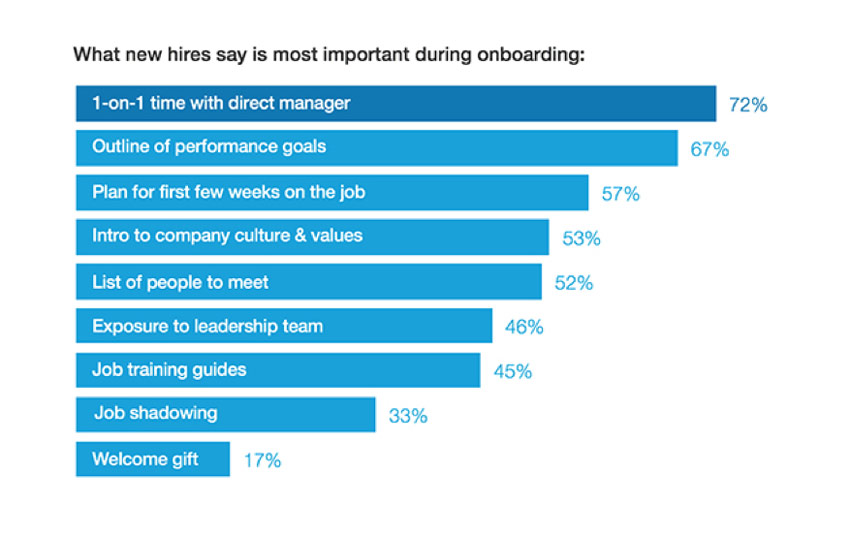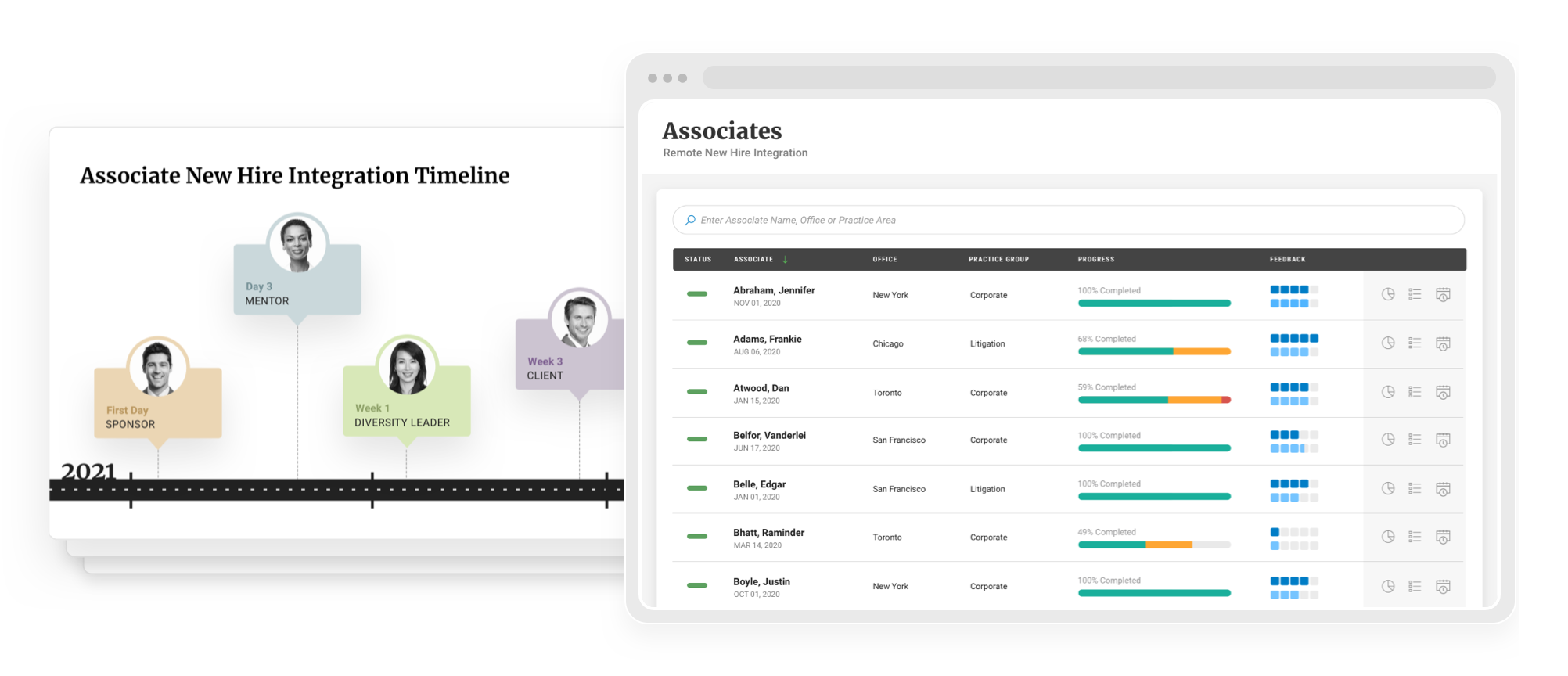
It’s no secret that employee integration is an issue affecting a lot of businesses right now. U.S. Department of Labor statistics show that last year alone, more than 3 million Americans a month walked out the door and didn’t come back.
What is it about employee integration that businesses struggle with? Is it one thing or many things? Is it about the new employee’s performance or their engagement?
Is it possible for an organization to create the perfect new employee integration strategy and execute the process flawlessly for each new hire?
If you’re an HR professional looking for ways to enhance your new hire onboarding program, or if you’ve decided to start fresh and build something stronger, more effective, and more efficient at your company, addressing these questions will be a great starting point. Let’s do so by reviewing the five things that leading companies do well when they onboard their new hires.
1. A comprehensive plan for employee integration
While it’s obvious that you’ll need a plan for onboarding new hires, there is usually a disconnect between an employee integration process and what new hires really want. In LinkedIn’s “Inside the Mind of Today’s Candidate” case study, 14,000 professionals across the globe were surveyed to find out which onboarding techniques they preferred.
72% of respondents rate one-on-one time with their direct manager as the most important onboarding requirement. An introduction to company culture and values is something that 53% want, and it ranked as the fourth most important element that new hires value. The elements you’d traditionally expect from an onboarding process, such as training and shadowing, rank a lot lower than down the list. This is probably because traditional onboarding just meant showing a new employee the ropes during orientation, whereas integration is a more long-term process that combines job performance and employee engagement.
When you create your plan to integrate new employees, be sure to focus on creating a balance between practical on-the-job activities (such as scheduled one-on-one time with direct managers, exposure to the leadership team, orientation and on-the-job training, outlining performance goals and the metrics that influence them) and cultural immersion activities (such as team get-togethers, where your employees will be able to rub shoulders with their colleagues).

2. An understanding that people are different
More than a decade ago, a new generation of employees entered the workforce and began to cause a stir. Millennials are an ambitious and focused generation that want to learn more and be better.
Now Generation Z has entered the workforce. There’s a lot of speculation about the best ways to integrate Gen Zs, and whether they are as ambitious as their predecessors. One thing is certain though: most organizations employ a combination of Baby Boomers, Millennials, and Gen Zs.
The question is: how do you handle different generations and their aspirations, and ensure that your employee integration plan is effective at employee engagement?
Employee integration should always follow a set structure, and the structure of your program should be something that your new hires understand. When it comes to welcoming new employees, regardless of their age or background, the single most important thing you can do is get them fully immersed in your company culture throughout the integration process.
Show them the best examples of teamwork, responsibility, and accountability, and make it easy for them to connect the dots between where they are as new employees and how they can fit into your team. Then they can integrate into your organization’s culture in a way that plays to their unique experiences, personality, and background.
3. Opportunities for new employees to make connections
Joining an organization as a new employee is like starting out at a new school. You don’t know anybody, you have no friends, and break time can be a painfully lonely experience. According to the LinkedIn case study above, 52% of respondents want to receive a list of all co-workers who they should meet, or want to have these meetings set up on their behalf. It’s hard to spend your first 90 days walking up to people at random and introducing yourself, or trying to force awkward water cooler conversations.
As an HR professional, you can help make your new employees feel right at home from day one by finding out how they’d like to meet their co-workers and facilitating it. Presenting a list of key people they will want to connect with or arranging a meeting in an informal setting shows your new hires you value them and gives them an organic chance to socialize and get to know their team.
4. Room in the company for a new hire to grow
“I left because there was no room for growth” is one of the most common statements when employees quit a job. Of course, not everyone can or wants to be a manager, but most employees still want the chance to develop new skills and progress in their career. And in today’s competitive job market, technology is making it simpler for your top talent to find new ways to grow and new places to do so.
The gig economy is now a real threat to retaining your best talent, and few organizations know how to deal with this challenge. Creating your organization’s version of an internal gig economy is not as complex as it seems. For example, vi’s work allocation module gives organizations the tools to create internal gig marketplaces.
Your teams can use Internal marketplaces to advertise projects that require unique skills that might exist outside their department’s talent pool. This makes it possible for skilled staff with itchy feet and the desire to contribute to channel their energy back into your organization instead of elsewhere. It can also be hands-on training for staff to explore areas outside their role and develop new skills at work.
5. Managing and measuring feedback in real time
Much has been written about the best way to provide feedback to hungry employees. Elements such as the frequency and ratio of formal and informal feedback definitely matter, but keeping track of all feedback and making sure it happens at the right time isn’t always simple.
Top organizations make a point of embedding regular feedback sessions and real-time performance feedback into their integration plans. With the right software, feedback can be requested by the employee at any time and there are reminders for outstanding requests, as well as an automatic history of feedback.
This way, a new employee’s performance is guided and measured from the get go. Rather than running them through their training and hoping for the best, you get to see how they are adjusting and you can provide detailed feedback on the early work they take on. They have the chance to learn and improve at every stage, not just during their year-end reviews.
We’re here to help
Building a successful employee integration process requires a host of different elements. Chief among these are structure, a good understanding of employee diversity, helping new staff create meaningful connections with co-workers, giving them the opportunity to grow internally, measuring performance, and managing feedback.

Among our suite of people management software, we’ve got the software and best practices to help you create the ideal process to integrate new hires into your company.